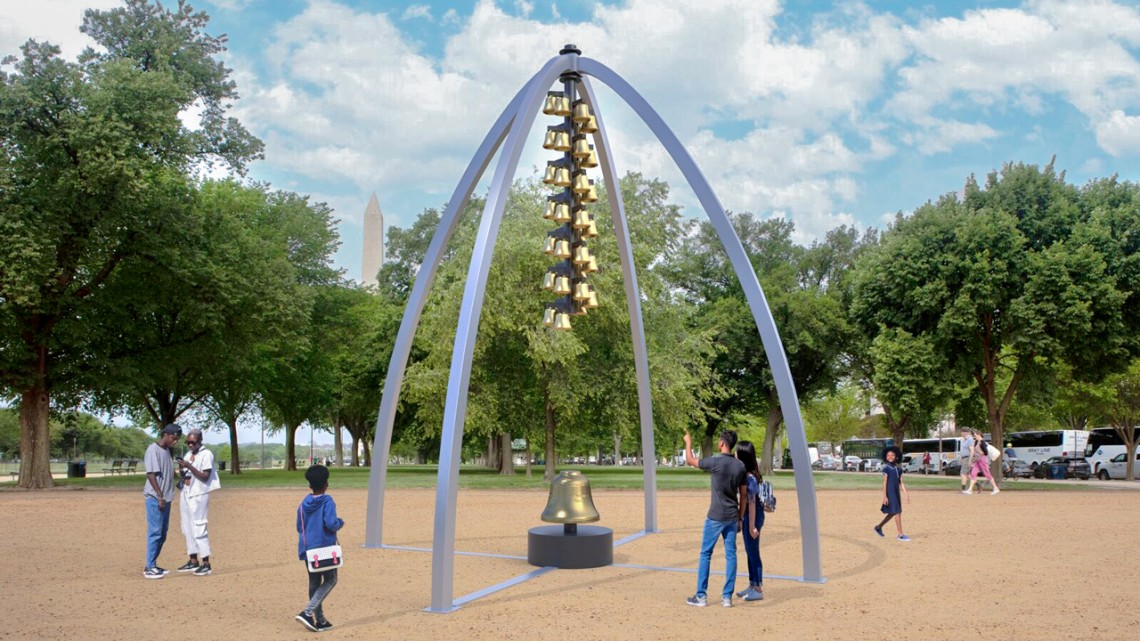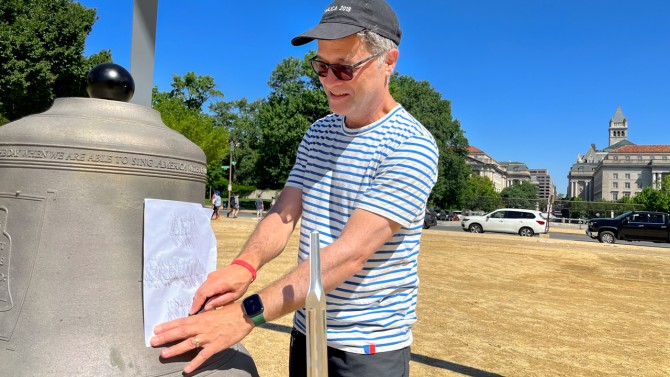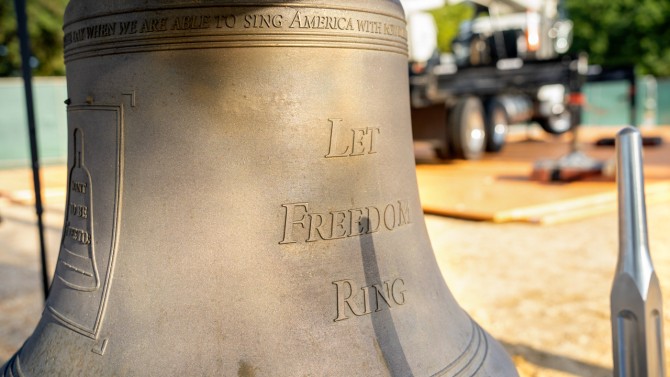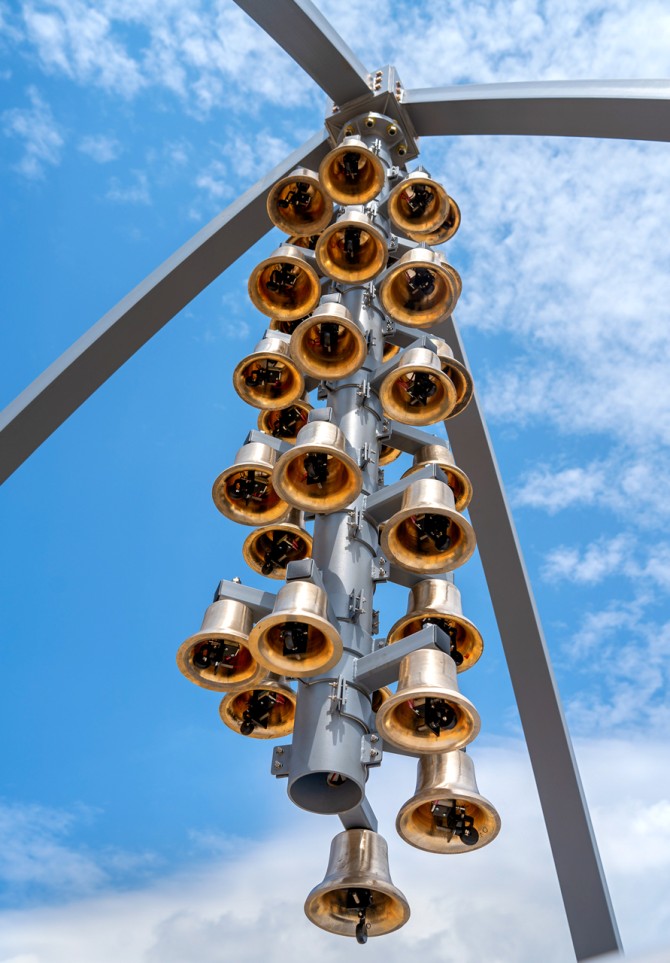
A rendering of “Let Freedom Ring,” a carillon designed by Paul Ramírez Jonas, chair of the Art Department in the College of Architecture, Art and Planning, for the “Beyond Granite: Pulling Together” exhibition on the National Mall through Sept. 18. The installation is one of six responding to the question, "What stories are missing on the National Mall?"
National Mall installation invites public to ‘let freedom ring’
By James Dean, Cornell Chronicle
On the National Mall in Washington starting Aug. 18, a newly assembled carillon will ring out “My Country, ’Tis of Thee,” the patriotic melody cascading down a column of spiraling bronze bells from a height of more than 22 feet.
Titled “Let Freedom Ring,” the temporary installation created by Paul Ramírez Jonas, professor and chair of the Art Department in the College of Architecture, Art and Planning, is one of six projects featured in “Pulling Together,” the first exhibition of the Beyond Granite initiative, which aims to create a more inclusive commemorative landscape on the mall.
The monthlong exhibition’s name and Ramírez Jonas’ interactive bell tower pay homage to Black opera singer Marian Anderson’s iconic 1939 performance of “My Country, ’Tis of Thee” – also known as “America” – at the Lincoln Memorial, after she was denied access to nearby Constitution Hall. Educator and civil rights activist Mary McLeod Bethune said the performance told “a story of pulling together, a story of splendor and real democracy.”
More than 80 years later, Ramírez Jonas presents another hopeful rendition – by asking the public to complete the song. Pulling a lever, they’ll trigger a hammer inside a 600-pound bell inscribed with “Let freedom ring” to strike song’s the final note, with a force they’ll both hear and feel.
“The only person who can finish the melody is you,” Ramírez Jonas said. “The song, like the promise of our country, remains incomplete without participation.”
‘Our monuments must change’
Funded by the Mellon Foundation, “Pulling Together” is co-curated by Paul Farber, director of Philadelphia-based nonprofit Monument Lab, and Salamishah Tillet, a Pulitzer Prize-winning professor at Rutgers University, who prompted the six invited artists – also including Derrick Adams, Tiffany Chung, Ashon T. Crawley, vanessa german and Wendy Red Star – with a question: What stories remain untold on the National Mall?
Across the country, Monument Lab’s 2021 audit of nearly 50,000 monuments documented that they depict figures who are overwhelmingly white and male. Among the top 50 individuals represented, half enslaved people, and just 6% are women – with mermaids represented more often than congresswomen.
“If we seek a nation that lives up to its creed, learns from and labors to repair its past, and connects to its history in ways that are more truthful, complex and vital,” the authors wrote, “then our monuments must change.”
With “Let Freedom Ring” – which also alludes to Martin Luther King’s 1963 “I Have a Dream” speech – Ramírez Jonas does not seek to represent any single story or identity. He said that’s partly because he lacks one himself: He was born in the U.S. but raised in Honduras, the son of Jewish and Catholic parents from Central and South America. He is both a citizen and an immigrant, Latino and white.
“The opportunity is that I can see all these sides,” he said. “I wanted a monument that’s essentially empty, and it gets filled by whomever walks up to it.”
Monumental language
Each day, more than 60,000 people are expected to pass “Let Freedom Ring” on an overpass above the 12th Street Expressway, accessible from the Smithsonian Metro stop, near the Smithsonian National Museum of American History and in view of the Washington Monument.
Welcoming any of them to complete “America” – which was considered one of several national anthems prior to “The Star-Spangled Banner’s” adoption in 1931 – Ramírez Jonas said the piece speaks to the United States’ ever-changing nature, something not reflected in its monuments.
“When it came to monumentality, we took a European model,” he said. “We didn’t invent a language about monumentality that accounts for a country that’s always changing its composition.”
“Let Freedom Ring” consists of four Gothic arch-like steel beams that support a vertical pillar holding 32 small bronze bells, arranged in a spiral over the much larger bell anchored to the ground – all cast by a Virginia foundry to sound specific notes in descending order. Ramírez Jonas said form followed function: The physics of suspending heavy bells high up, combined with weather and safety requirements, led to a design that references church bell towers.
“You end up with a traditional solution because you’re adapting to the conditions of public space,” Ramírez Jonas said. “Monuments look a certain way for a reason.”
Ramírez Jonas reinterprets those forms by encouraging public participation in ways that prompt reflection and more personal connections and meaning. A recurring theme, he said, is his belief that it is daily promises and commitments, small social contracts often taken for granted, that build public trust and bind people together.
“What if our monuments could remind us of these little bonds?” he said.
Last year in Birmingham, England, and previously in New York City, his public art project “Key to the City” enabled thousands of people to bestow the honorary civic symbol on others and unlock hidden spaces. And his equestrian monument, “The Commons” – a version of which will be featured at the upcoming Chicago Architecture Biennale – presents a riderless cork horse that does not project military authority or heroism, but becomes a platform on which the public can pin notes for others to read.
“He has a knack for envisioning and building projects that are bold, meaningful, inquisitive and inviting,” said Farber, calling Ramírez Jonas one of today’s most gifted and generous public artists. “‘Let Freedom Ring’ resounds with Ramírez Jonas’ sense of civic participation-meets-imagination.”
Freedom to, or freedom from?
Before participants pull the lever to ring the last bell measuring more than two feet tall and wide, Ramírez Jonas asks them to declare why they are doing it: Are they celebrating “freedom to” do something, or “freedom from” something? They can preserve their choice in a graphite rubbing of one of those two prompts, inscribed on opposite sides of the bell.
“I’m not telling you what your idea of freedom is,” Ramírez Jonas said. “I’m just suggesting that there’s flexibility, that there’s room for inserting yourself.”
Another inscription shows the song’s first verse with selected words missing, inviting participants to modify the lyrics – as Anderson did when she sang “our country” instead of “my country,” and “we sing” instead of “I sing.”
The process of “pulling together,” Ramírez Jonas said, occurs through awareness of others’ expressions of freedom and a sense of collective responsibility. Reflecting a bias toward optimism, Ramírez Jonas said, he never contemplated a design that might have rendered “America” unable to be completed.
“The bell works,” he said, “but it needs you.”
“Pulling Together” runs through Sept. 18 and is presented by the Trust for the National Mall in partnership with the National Capital Planning Commission and National Park Service.
Media Contact
Abby Kozlowski
Get Cornell news delivered right to your inbox.
Subscribe



